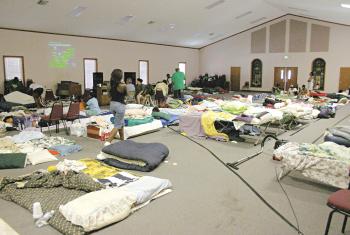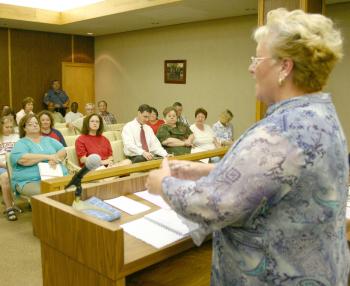
Evacuees filled the First Baptist Church of Eunice on Park Avenue following Hurricane Katrina’s landfall on Aug. 29, 2005. Former Eunice Mayor Lynn LeJeune said 3,864 evacuees arrived in Eunice. (Photo by Harlan Kirgan)
Former Eunice mayor remembers Katrina, Rita
Ten years ago today Hurricane Katrina formed over the Bahamas a matter of days strengthened to a Category 5 storm in the Gulf of Mexico.
The huge storm made landfall on Aug. 29 as Category 3.
Evacuees began arriving in Eunice on Sunday, the day before storm-driven water broke through levees and flooded the New Orleans area.
Lynn LeJeune, now president and chief executive officer of the St. Landry Chamber of Commerce, was Eunice’s mayor then and says she remembers those days almost every day.
But it wasn’t only Katrina. On Sept. 24, Hurricane Rita made landfall at Holly Beach.
Both hurricanes sent a wave of evacuees into Eunice
“It was such a horror,” LeJeune said. “Very, very often I recall the situation. We had to deal with sad situations.”
LeJeune said there 3,864 evacuees in Eunice from the storms. She remembers the numbers because the city started entering names into computers for contact information.
For Katrina, “As they came in a lot of them were pretty destitute because they didn’t have any money, they didn’t have any gas in their vehicles, they had children that were crying because there was no food. They had pretty much to leave in a major rush to get out of there,” she said.
The evacuees first filled up hotels but within 48 hours there were no more rooms.
Church congregations stepped up to the plate, she said.
“They set up kitchens. They set up resting areas, bathrooms, showers. Cleco came in and set up a big shower and bathroom in a trailer at the American Legion Hall that was for the use of the refugees,” LeJeune said.
“Whatever they had down in New Orleans, particularly in the 9th Ward, was gone,” LeJeune said. “So they had to find new housing. At the same time school is about to start. We had lots of children that, of course, they could not go back to their home school, so we started trying to find ways to get them into school. Again the churches and the schools and the local people raced out and got supplies, uniforms, shoes, all those things that these children needed to get into school.”
Supplies started coming in from across the nation.
“Little did I know it was going to come by the truckload,” she said. “It was everything that was needed. We set up a warehouse, one of those vacant stores in the Amy Shopping Center.”
Volunteers registered where the donations came from and placed them on tables for distribution.
“Then we opened up for the evacuees to come get what they needed. For the most part they were very considerate of not taking too much or not taking everything or being selfish about it,” LeJeune said.
“Then when it became very clear that FEMA was not going to be take them back to New Orleans or back in that area, they started taking them up to north Louisiana where they had larger facilities,” she said. “But a lot of those that were in the churches and in the homes, people had opened up their outdoor kitchens for them, and some of those hotels, they did not want to leave. They wanted to stay here. “
About 1,300 evacuees stayed in Eunice, she said.
“Then a lot them started trying to get a job, and get grounded and the children were in school and that was working out very well,” she said.
Some evacuees settled in Eunice.
The evacuee number was capped at 3,864 in four to five days after the storm, she said.
Pat Dossman and Dwight Jodon set up registration system for the evacuees because people were trying to find each other after the storm, she said.
An event was held at the Northwest Community Center where hamburgers and hot dogs were served.
“It allowed the adults to sit with people and tell them exactly what they needed and where we could contact relatives so that we could get them to come help them or bring them to their homes,” she said.
Then came Hurricane Rita.
“Right on top of that Rita came flying in,” she said “We started getting evacuees from the Lake Charles area. At that point I exported some of those people to Houston. There was a choice to go to Houston or Shreveport.”
The Rita evacuees stayed for three to five weeks, she said.
“Then they were able to go back to Lake Charles and get settled back down,” she said. “It was those from that New Orleans 9th Ward that were hit the worst.”
LeJeune said, “I‘ll tell you if it hadn’t been for the churches and the local people, we could have never reached out and helped them as much.”
The sheltering of evacuees went on for months, she said.
“... you always think what would you do if this hurricane came through your community and your people had to evacuate? You would hope somebody along the way would reciprocate and do the same thing for your people as well as we did for those,” she said.
LeJeune said she occasionally hears from former evacuees and even meets them while shopping.
“Those are things in life you just don’t forget,” she said.
- Log in to post comments


